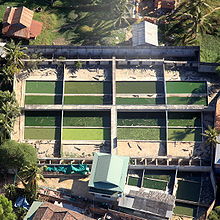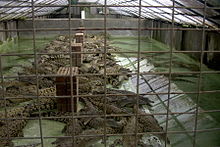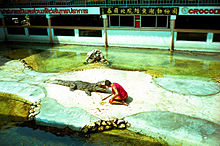- Alligator farm
-
For the album, see Alligator Farm (album).
 Aerial view of a Cambodian crocodile farm
Aerial view of a Cambodian crocodile farm
An alligator farm or crocodile farm is an establishment for breeding and raising of crocodilians in order to produce meat, leather, and other goods. Many species of both alligators and crocodiles are farmed internationally, and occasionally the term ranch is also used.
Contents
History
Though not truly domesticated, alligators and crocodiles have been bred in farms since at least the early 20th century. However, the vast majority of these early businesses were farms in name only; primarily keeping alligators and crocodiles as a tourist attraction.[1] The St. Augustine Alligator Farm Zoological Park, established in 1893, is a prime example of this early type of alligator farm. Only in the 1960s did commercial operations that either harvested eggs from the wild or bred alligators on-site begin to appear.[2] This was largely driven by diminishing stocks of wild alligators, which had been hunted nearly to extinction around this time.
As the American Alligator was placed under official protection in 1967 (under a law preceding the 1973 Endangered Species Act) farming alligators for skins became the most viable option for producing leather (outside illegal poaching).[2] Mostly concentrated in the Southern U.S. states of Louisiana, Florida, and Georgia, the practice quickly spread to other nations. Both the American and Chinese Alligator are farmed intensively today, mostly within each species' respective native region. The Nile crocodile is found in ranches all over Africa, and the Saltwater crocodile is farmed in Australia and other areas. The smaller caimans are generally not of enough market value to farm, though some captive breeding of the spectacled caiman does take place in South America.
Farming alligators and crocodiles first grew out of the demand for skins,[3] which can fetch hundreds of dollars apiece. But alligator and crocodile meat, which was long a part of Southern cooking (especially Cajun cuisine)[4] and some Asian and African cuisines, began to be sold later and shipped around the world to markets unfamiliar with crocodilian meat. Chinese cuisine based on traditional Chinese medicine considers alligator meat to be a curative food for colds and cancer prevention, although there is no scientific evidence to support this.[5]
In culture
A crocodile farm is featured in the 1973 James Bond film Live and Let Die. Tee Hee Johnson, one of the villain's henchman, attempts to feed James Bond to the crocodiles.
See also
- Turtle farming - commercial raising of another group of reptiles
References
- ^ "Crocodiles and Alligator Farms". americana-alligator.com. http://www.american-alligator.com/Crocodiles-and-Alligator-Farms.html.
- ^ a b Medley, Cynthia (January 18, 1970). "One Way to Halt Poaching-Gator Farming". The New York Times. http://select.nytimes.com/gst/abstract.html?res=F70A11FC345F16738DDDA10994D9405B808BF1D3&scp=2&sq=%22alligator%20farm%22&st=cse. Retrieved 2009-02-08.
- ^ Lyman, Rick (November 30, 1998). 20th "Anahuac Journal; Alligator Farmer Feeds Demand for All the Parts". The New York Times. http://query.nytimes.com/gst/fullpage.html?res=990CEFDA1538F933A05752C1A96E958260&sec=&spon=&&scp=3&sq=alligator%20meat&st=cse 20th.
- ^ Marcus, Frances Frank (April 4, 1993). "Louisiana Alligator, From Pies to Picante". The New York Times. http://query.nytimes.com/gst/fullpage.html?sec=travel&res=9F0CEEDB113DF937A35757C0A965958260&scp=2&sq=alligator%20meat&st=cse.
- ^ Chang, L. T., and Olson, R.. Gilded Age, Gilded Cage. National Geographic Magazine, May 2008.
Related articles on alligators, caimans, crocodiles and gharials Topics Human
interactionU.S. Alligator fatalities · Crocodile attacks · Alligator farm · Crocodile tears · Famous crocodiles and alligators · Sewer alligatorCategories:- Agricultural establishments
- Crocodilians
Wikimedia Foundation. 2010.


